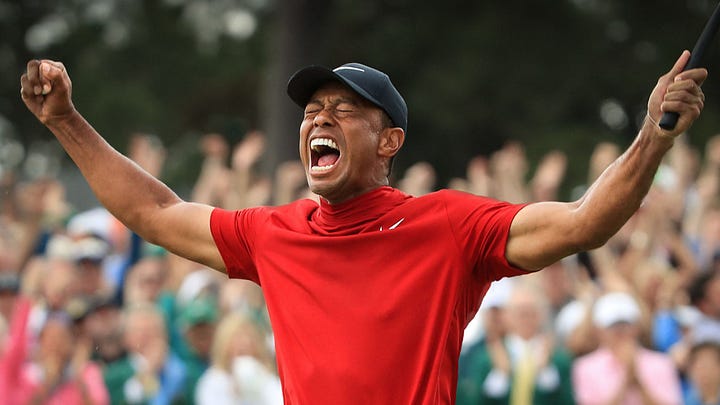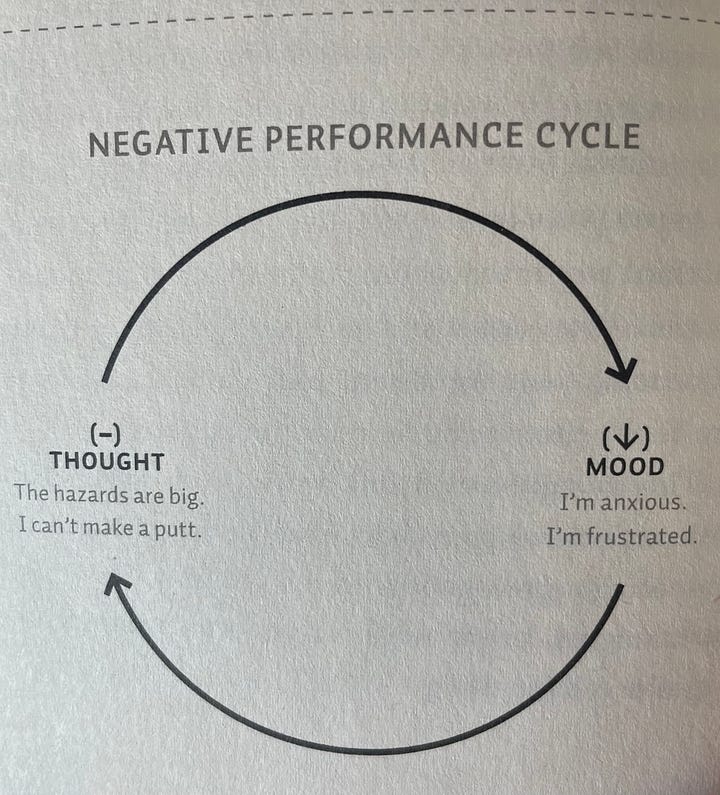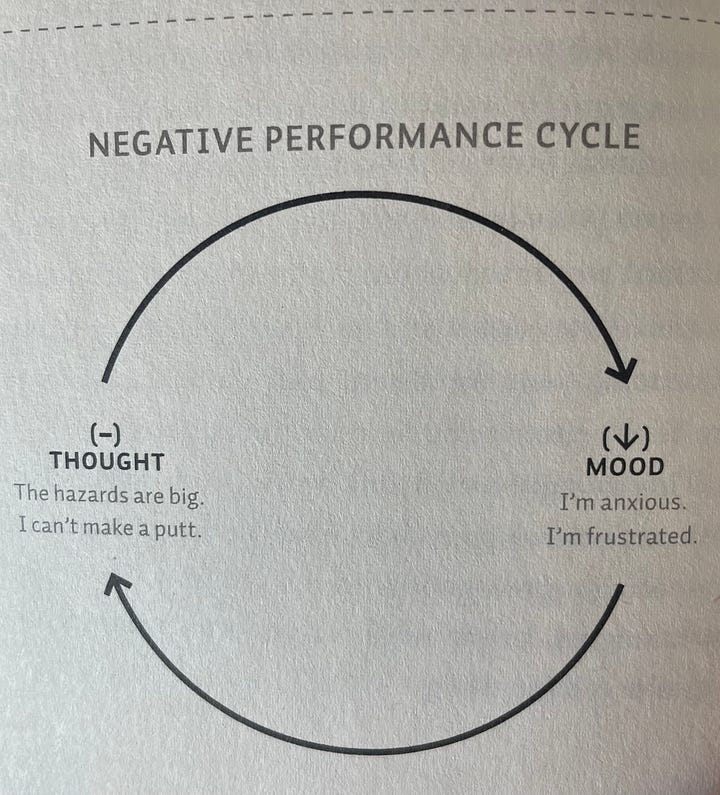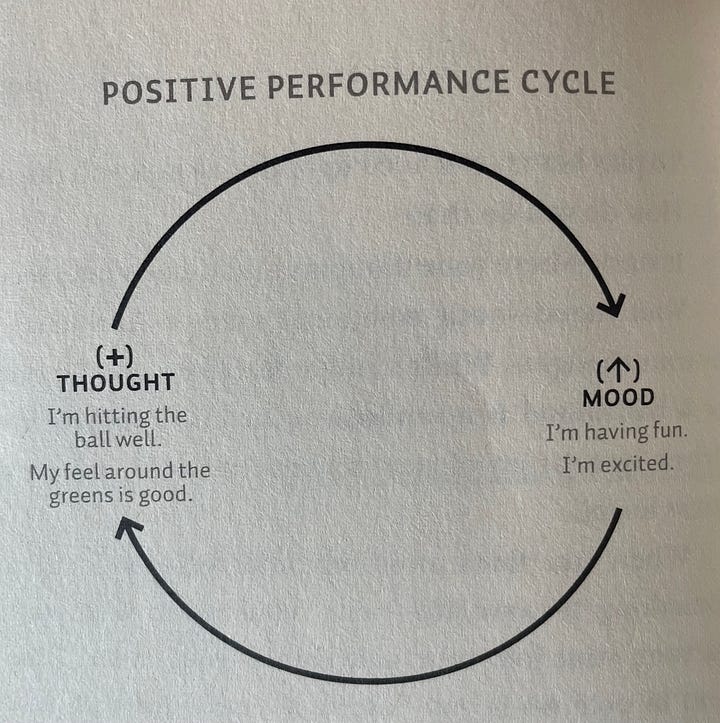The Best of November
Short Game Technique, Positive Negative Mood Cycles, Shortening Your Driver, Putter Launch, More GIRs, RIP Charlie Munger




Today’s post is another monthly best-of summary to resurface some things you might have missed. Click on the link for the full post. Enjoy!
Short Game Technique w/ Dan Grieves
Link: Edition #21
In this video, Dan Grieves goes through various short game shot types. Dan gears it towards winter golf, but most golfers will encounter many of these lies throughout the golf season.
Dan touches on multiple techniques for wet fairway shots, wet compact sand vs. fluffy sand, thick rough, uphill lies, hybrid chips, and pitch shots.
Dan is probably my favorite golf content coach online right now. His detail and instruction are next level.
This is a true masterclass in short-game technique. Give it a watch (22:31)
Avoid Negative Thought-Mood Cycles and Improve Your Game
Link: How Positive and Negative Thoughts Affect Your Performance
When we think of golf and “optimizing,” most of us think of our golf swing. But the low-hanging fruit is optimizing how we think. It not only has a larger impact on our golf game but it can be done without any coaching.
In his book Mastering Golf’s Mental Game, Dr. Michael Lardon writes that this optimization of the mind “starts where your thoughts and moods intersect.”
“Your mood—your emotional state—is influenced by your thoughts. While it might feel like a good mood or a bad mood is a random occurrence, moods are driven by a variety of factors: thoughts, sleep patterns, stress levels.”
In golf and life, when we think positively and feel good about something, we tend to perform a task better. The opposite is true as well. If we have a negative thought process, we tend to perform worse. We all intuitively know this concept, which Lardon calls the thought-mood link.


In the above diagram, Lardon shows how our thoughts on the course lead to negative or positive moods, which reinforce our next thought, which then affects our mood again. This becomes a perpetuating cycle that can spiral out of control if not checked.
Lardon says the goal is twofold:
Set ourselves up for a positive performance cycle as often as possible
Recognize when the inevitable negative thoughts and moods are coming before they damage our scores
So, how exactly do we do this? Lardon says we need to start noting our thoughts and use of language and evaluate to see if they distort the reality of the situation. We must then reframe our language for a more realistic and positive perspective.
<CLICK THE LINK FOR THE FULL POST>
Shortening Your Driver
Link: Edition #22
Lou Stagner posted a tweet on the benefits of shortening your driver shaft. I’ve discussed this a few times in the letter, but I think now might be a good time for some of you to experiment with a shorter driver. Link
The gist is that by shortening your driver, you will hit more centered strikes. So even though you lose some distance and club speed because of the shorter shaft, you gain most of it back because of the higher amount of center strikes. This also leads to better accuracy off the tee, leading to fewer offline shots and penalties.
As you can see, the player in the example above only lost 3 yards of distance, but their accuracy increased.
When I shortened my driver, I actually gained both distance and accuracy—a rare win-win. My driver was only cut down 1.5”, but it improved my strike quality and gave me more confidence to swing away.
Before you go cutting down your driver, go to your local fitter and see if you can test it out on a trackman. You might be surprised by the results.
🎄 🎁 The 2nd Cut: 2023 Holiday Gift Guide 🎁 🎄
Link: My favorite Golf Products, Gear, and Training Aids all in One Convenient Place
If you're still looking to build your Christmas list or buy something for the golfer in your life, check out my Holiday Gift Guide.
Putter Launch with Ross MacLeod
Link: Edition #23
Ross MacLeod (@rossmacleodputt) talks about a subject most of us amateurs don’t often consider: the launch and loft of our putters.
Do you know what your launch degree is? Do you know what is optimal? Did you even know putter launch was a thing?
I certainly didn’t know any of these answers until I got fitted. My launch was more than double the optimal range at 5+ degrees. I know that probably doesn’t mean much to you, but when you feel the difference, you’ll know immediately. After adjusting my putter (and some adjustments to my putting setup), I got down to a 2-degree launch. It’s not magic, but my average putts per round and shots gained dropped considerably after adjusting.
Check out the video and tweet below from Ross explaining what launch is, why it matters, and how to get it in an optimal range:
How to Hit More Greens in Regulation
Link: How to Hit More Greens
I won’t bury the lead. The answer is simple.
Aim for the center of the green, with a slight bias towards the back yardage.
Thats it. I promise if you take this approach, your GIRs will improve. No changes to your swing, no fancy tricks. You can quit reading now.
But I have a feeling some of you aren’t entirely convinced. And not too long ago, I felt the same way. Let’s dig into some of the math of why aiming at the center of the green and not flag-hunting is the answer.
Subscribed
Take More Club
Amateurs of all handicaps seldom take enough club. The chart below illustrates this issue:
As you can see, amateurs of all levels (even scratch golfers) rarely ever hit their approaches over the green, whereas shots short of the green are much more prevalent.
Lou Stagner had an excellent tweet that showed 0-5 handicappers hit 72% of greens with back pins and only 56% with front pins. They’ve found this to be true with pros as well.
No matter how you slice it, amateurs are biased toward leaving the ball short. So, give yourself a bigger margin for error by taking a middle and slightly back yardage!
<CLICK THE LINK FOR THE FULL POST>
Charlie Munger (1924 - 2023)
Link: Edition #24
Charlie Munger, investing genius, billionaire, longtime business partner of Warren Buffett, and the Vice Chairman of Berkshire Hathaway, died on Tuesday at the age of 99.
Charlie Munger was a modern-day Renaissance man. Even at the age of 99, he was as sharp as ever, giving interviews where he spoke extensively on subjects from physics to business, investing, and engineering.
Charlie was a big proponent of lifelong learning and reading voraciously. He believed that learning multiple mental models from various disciplines was the best way to understand the world and our own biases.
Charlie didn’t pontificate much on golf, but much of what he preached (especially about human bias and misjudgment) has made me a better golfer as well.
Since this is a golf newsletter, I’ll leave you with a few quotes that I think apply to golf as much as they do to life and investing:
“Patience can be learned. Having a long attention span and the ability to concentrate on one thing for a long time is a huge advantage.”
“If you're going to be an investor, you're going to make some investments where you don't have all the experience you need. But if you keep trying to get a little better over time, you'll start to make investments that are virtually certain to have a good outcome. The keys are discipline, hard work, and practice. It's like playing golf - you have to work on it.”
“Avoiding stupidity is easier than seeking brilliance.”
For those who know me, if there is one thing that rivals my passion for golf, it is my passion for investing. Charlie Munger has had a significant effect on my outlook on investing and life.
Charlie’s wisdom, sharp wit, and no-nonsense sensibility will be missed. A true one-of-a-kind. Rest in peace.
As always, if you have any questions or comments about the newsletter, please comment below or email me at the2ndcut@substack.com. I love hearing from readers; don’t be shy.
Have a great weekend!











